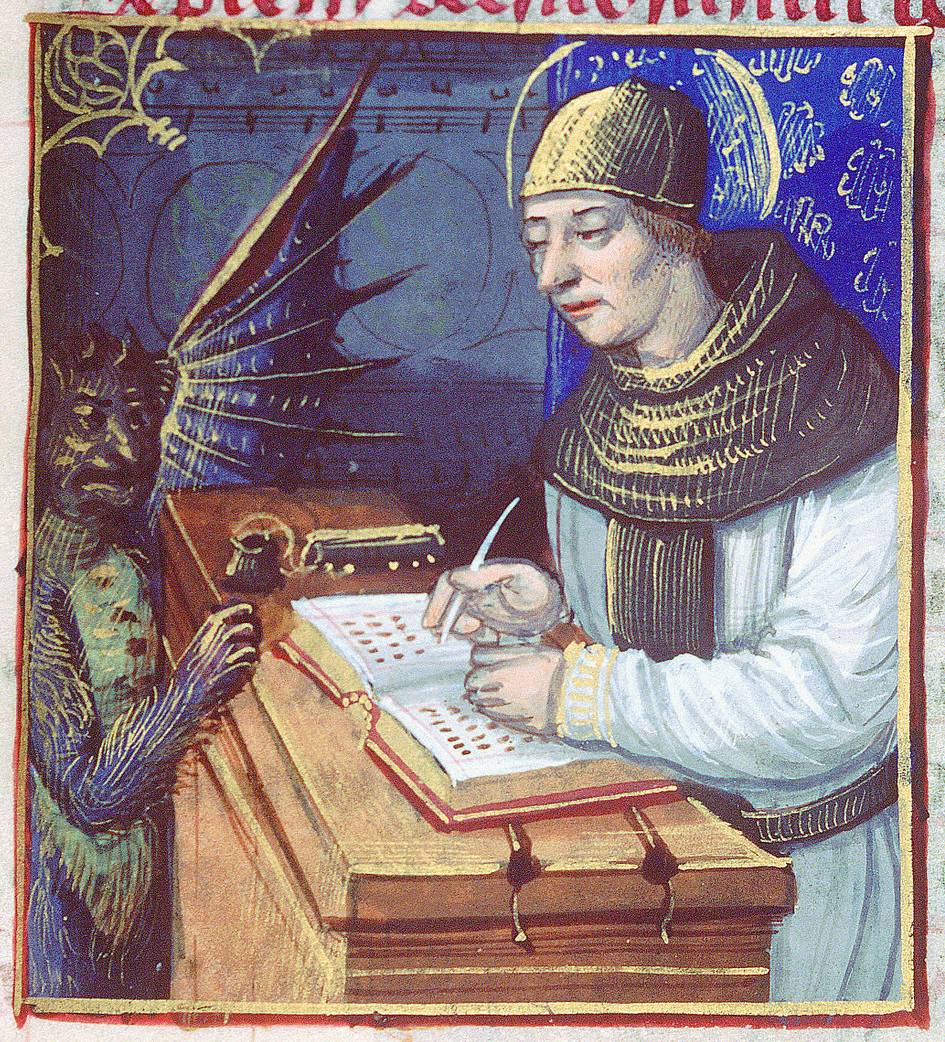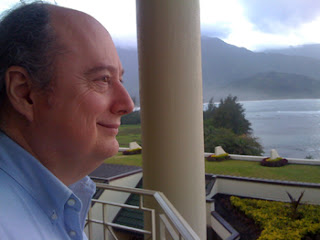 |
| Source |
Wikipedia's description of the image is:
Titivillus, a demon said to introduce errors into the work of scribes, besets a scribe at his desk (14th century illustration)
I'm David Rosenthal, and this is a place to discuss the work I'm doing in Digital Preservation.
 |
| Source |
Titivillus, a demon said to introduce errors into the work of scribes, besets a scribe at his desk (14th century illustration)
 |
| Source |
The final CNI membership meeting of Cliff’s tenure, held April 7–8, 2025, in Milwaukee, was to include a surprise presentation of the Festschrift’s table of contents. Though Cliff’s health prevented him from attending in person, he participated virtually and heard readings of excerpts from each contribution. Clifford Lynch passed away shortly after, on April 10, 2025. Authors completed their essays before his passing, and the original text remains unchanged.Below the fold is a bried snippet of each of the invited contributions and some comments.
 Because Nvidia became one of the most valuable companies in the world, there are now two books explaining its rise and extolling the genius of Jensen Huang, Tae Kim's The Nvidia Way: Jensen Huang and the making of a tech giant, and Steven Witt's The Thinking Machine: Jensen Huang, Nvidia, and the World's Most Coveted Microchip. For the later 90% of the history I wasn't there, so I won't comment on their treatment of that part. But for the pre-history at Sun Microsystems and the first 10% of the history I was there. Kim's account of the business side of this era is detailed and, although it was three decades ago, matches my recollections.
Because Nvidia became one of the most valuable companies in the world, there are now two books explaining its rise and extolling the genius of Jensen Huang, Tae Kim's The Nvidia Way: Jensen Huang and the making of a tech giant, and Steven Witt's The Thinking Machine: Jensen Huang, Nvidia, and the World's Most Coveted Microchip. For the later 90% of the history I wasn't there, so I won't comment on their treatment of that part. But for the pre-history at Sun Microsystems and the first 10% of the history I was there. Kim's account of the business side of this era is detailed and, although it was three decades ago, matches my recollections. Witt's account of the business side of the early history is much less detailed and some of the details don't match what I remember.
Witt's account of the business side of the early history is much less detailed and some of the details don't match what I remember.The first time I asked Priem about the architecture of the NV1, he spoke uninterrupted for twenty-seven minutes.Below the fold, I try to explain what Curtis was talking about for those 27 minutes. It will take me quite a long post.
 |
| Source |
Clifford Lynch is widely regarded as an oracle in the culture of networked information. Lynch monitors the global information ecosystem for cultural trends and technological developments. He ponders their variables, interdependencies and influencing factors. He confers with colleagues and draws conclusions. Then he reports his observations through lectures, conference presentations and writings. People who know about Lynch pay close attention to what he has to say.Below the fold are some additional personal notes on Cliff's contributions.
Lynch is a soft-spoken man whose work, for more than thirty years, has had an impact — directly or indirectly — on the computer, information and library science communities.
| Year | Awardee |
|---|---|
| 2024 | Tony Hey |
| 2022 | Paul Courant |
| 2020 | Francine Berman |
| 2017 | Herbert Van de Sompel |
| 2014 | Donald A.B. Lindberg |
| 2011 | Christine L. Borgman |
| 2008 | Daniel E. Atkins |
| 2006 | Paul Ginsparg |
| 2004 | Brewster Kahle |
| 2002 | Vinton Gray Cerf |
| 2000 | Tim Berners-Lee |
 |
| Original Logo |
 |
| NV1-based Diamond Edge Swaaye, CC-By-SA 3.0 |
In the name of blatant self-promotion, below the fold I look at how this insight has held up since.
- The income to a participant in a P2P network of this kind should be linear in their contribution of resources to the network.
- The costs a participant incurs by contributing resources to the network will be less than linear in their resource contribution, because of the economies of scale.
- Thus the proportional profit margin a participant obtains will increase with increasing resource contribution.
- Thus the effects described in Brian Arthur's Increasing Returns and Path Dependence in the Economy will apply, and the network will be dominated by a few, perhaps just one, large participant.
 |
| Source |
 |
| X11R1 on Sun Techfury90 CC0 |
From: rws@mit-bold (Robert W. Scheifler) To: window@athena Subject: window system X Date: 19 June 1984 0907-EDT (Tuesday) I've spent the last couple weeks writing a window system for the VS100. I stole a fair amount of code from W, surrounded it with an asynchronous rather than a synchronous interface, and called it X. Overall performance appears to be about twice that of W. The code seems fairly solid at this point, although there are still some deficiencies to be fixed up. We at LCS have stopped using W, and are now actively building applications on X. Anyone else using W should seriously consider switching. This is not the ultimate window system, but I believe it is a good starting point for experimentation. Right at the moment there is a CLU (and an Argus) interface to X; a C interface is in the works. The three existing applications are a text editor (TED), an Argus I/O interface, and a primitive window manager. There is no documentation yet; anyone crazy enough to volunteer? I may get around to it eventually. Anyone interested in seeing a demo can drop by NE43-531, although you may want to call 3-1945 first. Anyone who wants the code can come by with a tape. Anyone interested in hacking deficiencies, feel free to get in touch.Scheifler was right that it was a "good starting point for experimentation", but it wasn't really a usable window system until version 11 was released on 15th September 1987. I was part of the team that burned the midnight oil at MIT to get that release out, but my involvement started in late 1985.
 |
| Source |
 |
| Source |
 Yesterday, at the DigiPres conference, Vicky Reich and I were awarded a "Sustainability Excellence Award" by the National Digital Stewardship Alliance. This is a tribute to the sustained hard work of the entire LOCKSS team over more than a quarter-century.
Yesterday, at the DigiPres conference, Vicky Reich and I were awarded a "Sustainability Excellence Award" by the National Digital Stewardship Alliance. This is a tribute to the sustained hard work of the entire LOCKSS team over more than a quarter-century. This post celebrates my weird old car's 30thbirthday. It is a Mazda RX-7 dated November 1993, carrying the California license RX7 DSHR. I bought it new and in the almost 30 years since have driven it for nearly 140K miles. Unusually for an RX-7 this old, it is almost completely stock and has never been on a track.
This post celebrates my weird old car's 30thbirthday. It is a Mazda RX-7 dated November 1993, carrying the California license RX7 DSHR. I bought it new and in the almost 30 years since have driven it for nearly 140K miles. Unusually for an RX-7 this old, it is almost completely stock and has never been on a track. Happy 25th Birthday LOCKSS! The fifteen-year retrospective is here, and the twenty-year one is here, in which I wrote:
Happy 25th Birthday LOCKSS! The fifteen-year retrospective is here, and the twenty-year one is here, in which I wrote:Thanks again to the NSF, Sun Microsystems, and the Andrew W. Mellon Foundation for the funding that allowed us to develop the system. Many thanks to the steadfast support of the libraries of the LOCKSS Alliance, and the libraries and publishers of the CLOCKSS Archive, that has sustained it in production. Special thanks to Don Waters for facilitating the program's evolution off grant funding, and to Margaret Kim for the original tortoise logo.Now for some more gratuitous self-promotion. This means:
 I was asked to talk about cryptocurrencies to the 49th Asilomar Microcomputer Workshop. I decided that my talk would take the form of a chronology, so I based the title on a book by the late, great comic Spike Milligan. It became Crypto: My Part In Its Downfall1.
I was asked to talk about cryptocurrencies to the 49th Asilomar Microcomputer Workshop. I decided that my talk would take the form of a chronology, so I based the title on a book by the late, great comic Spike Milligan. It became Crypto: My Part In Its Downfall1. One of the things our grandson is interested in is trains, especially steam trains. Via gifts from various friends and relations he accumulated a vast collection of the Brio wooden model trains and tracks; it is favorite plaything at our house. I added needed pieces to the collection by downloading models from the amazing selection of Brio-compatible pieces on Thingiverse and printing them using the Creality CR6-SE that I got via Kickstarter two years ago. These included switches, buffers, gender changers and long straight tracks.
One of the things our grandson is interested in is trains, especially steam trains. Via gifts from various friends and relations he accumulated a vast collection of the Brio wooden model trains and tracks; it is favorite plaything at our house. I added needed pieces to the collection by downloading models from the amazing selection of Brio-compatible pieces on Thingiverse and printing them using the Creality CR6-SE that I got via Kickstarter two years ago. These included switches, buffers, gender changers and long straight tracks. |
| E's & D's Adventures in Life CC BY 2.0 |